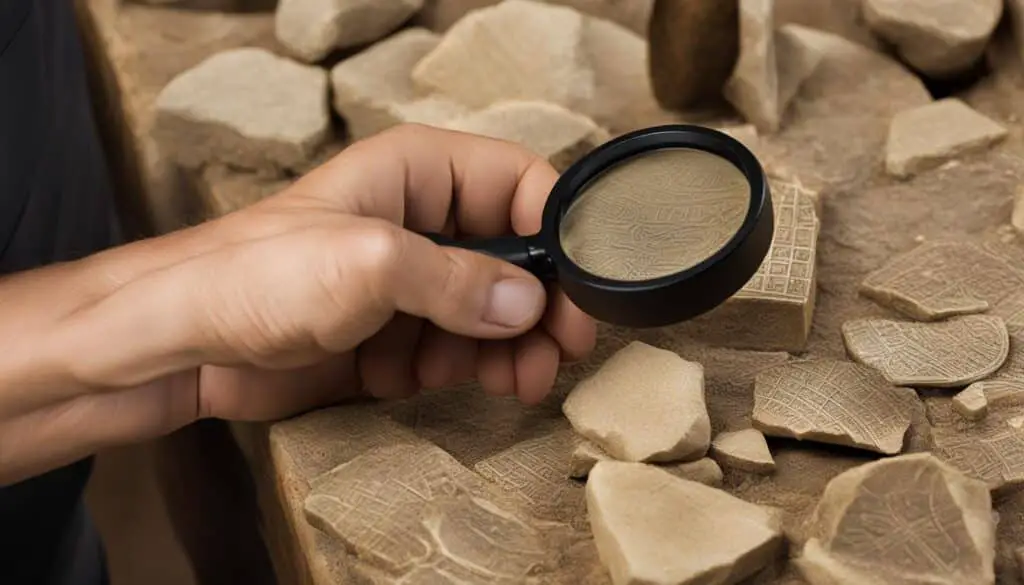
High-resolution photography has had a profound impact on the study of biblical artifacts, revolutionizing the field and providing researchers with invaluable insights into ancient relics. Through the use of advanced photographic techniques, high-resolution photography has the ability to capture images with remarkable detail and clarity, enabling the revelation of hidden features and a deeper understanding of these artifacts.
By employing high-resolution photography, scholars can uncover previously unseen details, enhancing our overall knowledge of ancient history. The power to magnify images to an unprecedented level allows researchers to identify intricate patterns, faded inscriptions, and even underlying layers of the artifact’s structure that may have otherwise gone unnoticed by the naked eye. This detailed analysis contributes to a more comprehensive understanding of the historical context, religious practices, and cultural significance of the artifacts, shedding light on the rich tapestry of biblical history.
Key Takeaways:
- High-resolution photography has revolutionized the study of biblical artifacts.
- It enables the capture of images with exceptional clarity and detail.
- High-resolution photography uncovers hidden features and provides a deeper understanding of ancient relics.
- Advanced imaging techniques can reveal faded inscriptions and intricate patterns.
- It contributes to a more comprehensive understanding of biblical history and its cultural significance.
Advantages of High-Resolution Photography in Biblical Artifact Study
The advantages of using high-resolution photography in biblical artifact study are numerous. First and foremost, this technique allows researchers to capture images of artifacts with exceptional clarity and detail. By photographing these objects at a high resolution, even the tiniest intricacies and subtle features become visible, aiding in the interpretation and analysis process.
High-resolution images serve as a crucial reference for future studies, enabling scholars from different locations and disciplines to access and examine the artifacts remotely. This remote access promotes collaboration and the sharing of knowledge, as experts can study the same high-resolution images without the need for physical proximity.
Moreover, the non-invasive nature of high-resolution photography ensures the preservation of the artifacts while still providing valuable information. Unlike traditional methods, which may require physical handling or sampling of the artifacts, high-resolution photography allows for thorough documentation without any risk of damage.
Furthermore, high-resolution photography enables researchers to capture images under various lighting conditions, enhancing the visibility of fine details and revealing new insights. By experimenting with different lighting angles and intensities, scholars can highlight specific features or textures that may have been overlooked in previous studies.
Overall, the advantages of high-resolution photography in biblical artifact study are undeniable. This advanced photographic technique empowers researchers to uncover hidden details, facilitate remote collaboration, ensure artifact preservation, and gain a deeper understanding of ancient relics.
Capturing Minute Details
One of the key advantages of high-resolution photography is its ability to capture even the tiniest intricacies and subtle features of biblical artifacts. By photographing objects at a high resolution, researchers can closely examine every minute detail, such as faded inscriptions, intricate patterns, or delicate brushwork. This level of detail aids in the interpretation and analysis process, allowing scholars to gain deeper insights into the historical and cultural significance of the artifacts.
In many cases, high-resolution photography has revealed hidden details that were previously unknown or misunderstood. For example, by capturing high-resolution images of a fragment of an ancient manuscript, scholars were able to decipher faint traces of text that provided valuable insights into biblical translation practices during that time period.
Remote Collaboration and Access
High-resolution photography also enables scholars from different locations and disciplines to collaborate and access the same artifacts remotely. By digitizing the images and making them easily accessible through online databases, researchers can study and analyze the artifacts without the need for physical travel or handling. This promotes collaboration among experts from around the world, fostering a diverse range of perspectives and expertise.
Through remote collaboration, scholars can collectively study high-resolution images of biblical artifacts, exchanging ideas and interpretations. Such collaborative efforts have led to significant breakthroughs in understanding ancient religious practices and cultural contexts, enhancing the overall knowledge in the field of biblical artifact study.
Preservation of Artifacts
High-resolution photography offers a non-invasive method of documenting and preserving biblical artifacts. Unlike traditional methods, which may require physical contact or sampling, high-resolution photography ensures the artifact’s physical integrity remains intact while still providing valuable information. This preservation aspect is particularly crucial for fragile or rare artifacts that may be prone to damage.
By creating high-quality, detailed images of the artifacts, scholars can comprehensively document their condition and monitor any changes or deterioration over time. These images serve as a record that can be referenced during restoration efforts or shared with preservation experts, providing critical information for the long-term preservation of these invaluable cultural and religious artifacts.
Enhancing Documentation and Preservation Efforts
High-resolution photography plays a vital role in documenting and preserving biblical artifacts. The detailed images captured through this technique provide an accurate record of the artifact’s condition, allowing researchers to monitor any changes or deterioration over time.
Moreover, high-resolution photographs can aid in the restoration process by serving as references during conservation efforts. By digitally preserving the artifacts through high-resolution photography, scholars can ensure their longevity and access to future generations. This innovative approach to documentation and preservation safeguards these valuable historical items from potential damage or loss.
| Benefits of High-Resolution Photography in Documentation and Preservation |
|---|
| Evidence-based record of artifact’s condition |
| Facilitates remote analysis and collaboration among scholars |
| Preserves artifacts while providing valuable information |
With high-resolution photographs serving as a visual representation of these artifacts, researchers can examine their condition and identify any signs of deterioration. This proactive approach allows them to implement timely preservation measures, such as controlled environments or specialized storage techniques, to mitigate further damage.
Furthermore, high-resolution photography enables scholars to share their findings and collaborate with colleagues across geographical boundaries. By having access to detailed images, experts from various disciplines can contribute their insights and expertise, enriching the collective knowledge about these biblical artifacts.
“High-resolution photography has become an indispensable tool for documenting and preserving biblical artifacts. Through the power of detailed imagery, we can ensure the long-term conservation of these invaluable historical treasures.”
– Dr. Sarah Stewart, Archaeologist and Preservation Specialist
By digitally preserving the artifacts through high-resolution photography, researchers can safeguard these objects from potential damage or loss. They become part of an accessible and comprehensive archive that can be studied and admired by future generations, contributing to the ongoing understanding of biblical history and culture.
Unlocking Hidden Details and Insights
High-resolution photography has the remarkable ability to unveil hidden details and uncover new insights in biblical artifact study. By magnifying the images to an unprecedented level, researchers can identify minute details that may have gone unnoticed to the naked eye. This includes faded inscriptions, intricate patterns, or even the underlying layers of the artifact’s structure. Through advanced imaging techniques, such as multispectral analysis, high-resolution photography assists in revealing faint traces and deciphering ancient scripts. These discoveries shed light on the historical context, religious practices, and cultural significance of the artifacts, contributing to a more comprehensive understanding of biblical history.

| Hidden Details Unveiled through High-Resolution Photography | Insights Obtained |
|---|---|
| Faded Inscriptions | Revealing forgotten texts or contextual clues |
| Intricate Patterns | Understanding artistic techniques, symbolism, or cultural motifs |
| Underlying Layers | Exploring construction methods, materials used, or hidden compartments |
High-resolution photography not only captures the surface appearance of biblical artifacts but also delves deeper to expose hidden details that may hold significant historical, religious, or cultural importance. These newfound insights offer valuable contributions to the ongoing study of ancient civilizations and their intricate artifacts. With each hidden detail brought to light, high-resolution photography continues to deepen our understanding of the rich tapestry of biblical history.
Conclusion
In conclusion, high-resolution photography has revolutionized the study of biblical artifacts. The exceptional clarity and detail captured through this technique enable researchers to analyze and interpret ancient relics more effectively. With enhanced documentation, preservation, and the revelation of hidden details and insights, high-resolution photography plays a vital role in unlocking the wealth of knowledge embedded in these cultural and religious artifacts.
Through the use of high-resolution photography, scholars gain a deeper understanding of biblical history and the ancient world. This advanced photographic technique preserves and safeguards these invaluable artifacts for future generations, while also providing a platform for remote examination and collaboration among researchers worldwide.
By harnessing the power of high-resolution photography, the study of biblical artifacts continues to push the boundaries of knowledge and exploration. Through the meticulous examination of these images, researchers uncover hidden details, decipher ancient scripts, and shed light on the cultural and religious practices of the past.
High-resolution photography stands as a testament to the impact of modern technology in our understanding of the biblical world. As scholars continue to utilize this technique, we can expect further discoveries and insights that will deepen our knowledge and appreciation of the intricate history and significance of these artifacts.
FAQ
How has high-resolution photography revolutionized the study of biblical artifacts?
High-resolution photography has revolutionized the field of biblical artifact study by capturing images with exceptional clarity and detail. This advanced photographic technique enables researchers to uncover hidden features and gain deeper insights into these ancient relics.
What are the advantages of using high-resolution photography in biblical artifact study?
The advantages of high-resolution photography in biblical artifact study are numerous. This technique allows researchers to capture images with exceptional clarity and detail, revealing even the tiniest intricacies and subtle features. Additionally, the non-invasive nature of high-resolution photography ensures the preservation of the artifacts while still providing valuable information. It also serves as a crucial reference for future studies, enabling scholars from different locations and disciplines to access and examine the artifacts remotely.
How does high-resolution photography contribute to the documentation and preservation of biblical artifacts?
High-resolution photography plays a vital role in documenting and preserving biblical artifacts. The detailed images captured through this technique provide an accurate record of the artifact’s condition, allowing researchers to monitor any changes or deterioration over time. These photographs also aid in the restoration process by serving as references during conservation efforts. By digitally preserving the artifacts through high-resolution photography, scholars can ensure their longevity and access to future generations.
How does high-resolution photography help in uncovering hidden details and insights in biblical artifact study?
High-resolution photography has the remarkable ability to unveil hidden details and uncover new insights in biblical artifact study. By magnifying the images to an unprecedented level, researchers can identify minute details that may have gone unnoticed to the naked eye. Through advanced imaging techniques, such as multispectral analysis, high-resolution photography assists in revealing faint traces and deciphering ancient scripts. These discoveries shed light on the historical context, religious practices, and cultural significance of the artifacts, contributing to a more comprehensive understanding of biblical history.
How does high-resolution photography impact the study of biblical artifacts?
High-resolution photography has significantly impacted the study of biblical artifacts. Its ability to capture images with exceptional clarity and detail has revolutionized the field, enabling researchers to analyze and interpret ancient relics more effectively. The advantages of high-resolution photography include enhanced documentation, preservation, and the revelation of hidden details and insights. By harnessing this advanced photographic technique, scholars are able to unlock a wealth of knowledge about biblical history and artifacts, furthering our understanding of the ancient world.








